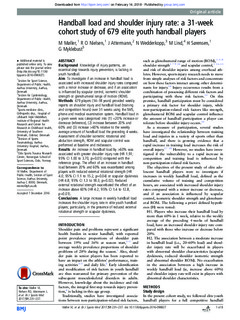| dc.contributor.author | Møller, Merete | |
| dc.contributor.author | Nielsen, Rasmus Østergaard | |
| dc.contributor.author | Attermann, Jørn | |
| dc.contributor.author | Wedderkopp, Niels | |
| dc.contributor.author | Lind, Martin | |
| dc.contributor.author | Sørensen, Henrik | |
| dc.contributor.author | Myklebust, Grethe | |
| dc.date.accessioned | 2018-05-18T12:37:30Z | |
| dc.date.available | 2018-05-18T12:37:30Z | |
| dc.date.created | 2017-06-28T10:15:56Z | |
| dc.date.issued | 2017 | |
| dc.identifier.citation | British Journal of Sports Medicine. 2017, 51, 231-237. | nb_NO |
| dc.identifier.issn | 0306-3674 | |
| dc.identifier.uri | http://hdl.handle.net/11250/2498587 | |
| dc.description.abstract | Background: Knowledge of injury patterns, an essential step towards injury prevention, is lacking in youth handball. Aim: To investigate if an increase in handball load is associated with increased shoulder injury rates compared with a minor increase or decrease, and if an association is influenced by scapular control, isometric shoulder strength or glenohumeral range of motion (ROM). Methods: 679 players (14–18 years) provided weekly reports on shoulder injury and handball load (training and competition hours) over 31 weeks using the SMS, phone and medical examination system. Handball load in a given week was categorised into (1) <20% increase or decrease (reference), (2) increase between 20% and 60% and (3) increase >60% relative to the weekly average amount of handball load the preceding 4 weeks. Assessment of shoulder isometric rotational and abduction strength, ROM and scapular control was performed at baseline and midseason. Results: An increase in handball load by >60% was associated with greater shoulder injury rate (HR 1.91; 95% CI 1.00 to 3.70, p=0.05) compared with the reference group. The effect of an increase in handball load between 20% and 60% was exacerbated among players with reduced external rotational strength (HR 4.0; 95% CI 1.1 to 15.2, p=0.04) or scapular dyskinesis (HR 4.8; 95% CI 1.3 to 18.3, p=0.02). Reduced external rotational strength exacerbated the effect of an increase above 60% (HR 4.2; 95% CI 1.4 to 12.8, p=0.01). Conclusions: A large increase in weekly handball load increases the shoulder injury rate in elite youth handball players; particularly, in the presence of reduced external rotational strength or scapular dyskinesis. | nb_NO |
| dc.language.iso | eng | nb_NO |
| dc.subject | adolescent | nb_NO |
| dc.subject | epidemiology | nb_NO |
| dc.subject | load | nb_NO |
| dc.subject | risk factor | nb_NO |
| dc.subject | Scapula | nb_NO |
| dc.title | Handball load and shoulder injury rate: A 31-week cohort study of 679 elite youth handball players | nb_NO |
| dc.type | Journal article | nb_NO |
| dc.type | Peer reviewed | nb_NO |
| dc.description.version | publishedVersion | nb_NO |
| dc.rights.holder | © BMJ Publishing Group | nb_NO |
| dc.source.journal | British Journal of Sports Medicine | nb_NO |
| dc.identifier.doi | 10.1136/bjsports-2016-096927 | |
| dc.identifier.cristin | 1479403 | |
| dc.description.localcode | Seksjon for idrettsmedisinske fag / Department of Sport Medicine | nb_NO |
| cristin.unitcode | 150,34,0,0 | |
| cristin.unitname | Seksjon for idrettsmedisinske fag | |
| cristin.ispublished | true | |
| cristin.fulltext | original | |
| cristin.qualitycode | 2 | |
